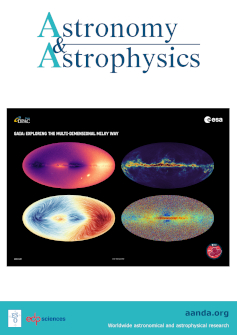Reduced or westward hotspot offset explained by dynamo action in atmospheres of ultrahot Jupiters
IF 5.4
2区 物理与天体物理
Q1 ASTRONOMY & ASTROPHYSICS
引用次数: 0
Abstract
Hot Jupiters are tidally locked, Jupiter-sized planets in close proximity to their host star, exhibiting equilibrium temperatures exceeding 1000 K. Photometric observations often reveal that the hotspot - the hottest location in the atmosphere - has shifted with respect to the substellar point. While both eastward and westward offsets have been observed, hydrodynamic simulations typically predict an eastward offset due to advection by a characteristic eastward flow. In ultrahot Jupiters, where equilibrium temperatures surpass 2000 K, increased ionization has enhanced the electrical conductivity, leading to substantial Lorentz forces that can significantly influence the atmospheric dynamics. Here we present magnetohydrodynamic numerical simulations of atmospheres in ultrahot Jupiters that fully capture nonlinear electromagnetic induction effects. Our study identifies a novel magnetic instability that profoundly alters the dynamics, characterized by the disruption of the well-known laminar mean flows. This instability is triggered by a sufficiently strong background magnetic field with a realistic amplitude of around 1 G, assumed to originate from a deep-seated dynamo. Upon increasing the background field to 2.5 G, a subcritical dynamo mechanism emerges, capable of sustaining itself even when the external background field is removed. While hydrodynamic models exhibit a typical eastward offset, the magnetic instability results in either a vanishing or a westward hotspot displacement. Our results suggest that radial flow patterns associated with the instability play a significant role in modifying the hotspot position, providing a new mechanism to explain the diversity of observed hotspot shifts.用超热木星大气中的发电机作用来解释减少或向西的热点偏移
热木星是潮汐锁定的,木星大小的行星靠近它们的主恒星,表现出超过1000 K的平衡温度。光度观测经常揭示热点——大气中最热的地方——相对于恒星下的点已经发生了变化。虽然已经观测到向东和向西偏移,但流体动力学模拟通常预测由于特征性的向东流动的平流而导致的向东偏移。在平衡温度超过2000 K的超热木星上,电离作用的增加提高了电导率,从而产生了大量的洛伦兹力,这可以显著影响大气动力学。在这里,我们提出了超热木星大气的磁流体动力学数值模拟,充分捕捉非线性电磁感应效应。我们的研究确定了一种新的磁不稳定性,它深刻地改变了动力学,其特征是众所周知的层流平均流的破坏。这种不稳定性是由一个足够强的背景磁场触发的,实际振幅约为1g,假设来自一个深层发电机。当背景场增加到2.5 G时,出现了一个亚临界发电机机制,即使在外部背景场被移除时也能够维持自身。虽然水动力模型表现出典型的向东偏移,但磁不稳定性导致热点消失或向西偏移。研究结果表明,与不稳定性相关的径向流动模式对热点位置的改变起着重要作用,为解释观测到的热点位移的多样性提供了新的机制。
本文章由计算机程序翻译,如有差异,请以英文原文为准。
求助全文
约1分钟内获得全文
求助全文
来源期刊

Astronomy & Astrophysics
地学天文-天文与天体物理
CiteScore
10.20
自引率
27.70%
发文量
2105
审稿时长
1-2 weeks
期刊介绍:
Astronomy & Astrophysics is an international Journal that publishes papers on all aspects of astronomy and astrophysics (theoretical, observational, and instrumental) independently of the techniques used to obtain the results.
 求助内容:
求助内容: 应助结果提醒方式:
应助结果提醒方式:


